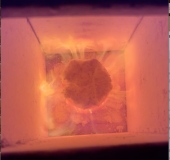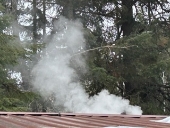
 4
4











 3
3




 7
7




regards, Peter
 4
4




Peter van den Berg wrote:Sorry to say, but I'm inclined to think you aren't on the right path. The round opening between the firebox and the secondary chamber is far too small in my opinion. None of my designs has a port that's smaller than 50% of chimney cross section area, 70% is much more common. I did some calculation: your 38 mm diameter hole is 6.4% of system csa. In order to rise that to at least 50%, it should be somewhere around 106 mm diameter. As it is now, gas speed is far too slow, turbulence is lazy and the really hot afterburner flame won't occur.
The volume of the secondary chamber should be enough to accommodate rapid expansion and lots of turbulence. To my eyes, it looks far too cramped now. What you could do is rising the secondary chamber's height to 200 mm again. The horseshoe height to 100 mm or thereabouts and have the riser resting on the horseshoe. Or, with a full height horseshoe, the top half as a complete square. By doing that, the hot gases have plenty of space and need to go down in order to get into the riser.
The firebox could be defined as high as wide, say, 250 mm, being not critical.
Signals to keep in mind:
There should be an audible roar, then you'll know there's lots of turbulence.
Assuming the whole of the thing is completely dry, smoke should disappear completely within 10 minutes, preferably in 5.
When the above points are met with an open system, all air inlet should be in the top half of the fiebox, 30% of system csa in total is enough.
If and when the thing is running like it should, the afterburner flames could rise out of the riser because there's no back pressure of a bell at present.
Of course lots of different configurations are possible, although in my experience just one or two will turn out being the best performers.
All the above recommendations are based on educated guessing. Whether or not you are implementing those is entirely up to you.
 4
4







 2
2




 4
4




regards, Peter

 7
7




For all your Montana Masonry Heater parts (also known as) Rocket Mass heater parts.
Visit me at
dragontechrmh.com Once you go brick you will never go back!
 4
4








 7
7




For all your Montana Masonry Heater parts (also known as) Rocket Mass heater parts.
Visit me at
dragontechrmh.com Once you go brick you will never go back!
 4
4




Dave Rose wrote:Actually I have a question - when reloading the Shorty or DSR3, do you typically expect some smoke when refuelling?
Dave Rose wrote:Oh and one more thing, I could potentially try a fibonacci spiral instead of a horseshoe. So instead of splitting the gases in two before recombining again, I could send them all the same direction and into a single vortex into the riser. The benefit (I think) would be a longer path for the gas, the drawback it would also be narrower, so may have to increase the height more, which wouldn't be ideal. But if you have any hunches on horseshoe vs fibonacci, please share!
regards, Peter
 2
2




 2
2




Dave Rose wrote:Ok, next test will be 200mm height, with a little stumbler attached to the top of the final port I think.
Dave Rose wrote:I’ve run a few more tests with smaller heights, but all seem to go into over fuel mode. The last one was 150mm and it seemed to oscillate between clean and over fuelling every couple of seconds, was interesting to watch. I concluded it was almost able to burn everything in the secondary chamber, but would periodically spew out the excess, resulting in puffs of smoke and or flames coming out the riser. So far then, the best burn by far has been at your suggested 200mm height, despite attempts to prove otherwise! I also tinkered with a Fibonacci, but at 100mm height - it made a nice vortex, but the burn wasn’t great, in line with the other at this height. I might test again if I find a solid configuration as I like how it looks, but it’s interesting to hear your experience.
Dave Rose wrote:Have you published any final dimensions for the Shorty? I searched your main thread and a couple of others, I did find reference to a sketchup file but couldn’t find it or the dimensions anywhere. I’d be interested to compare the dimensions of the different chambers and port sizes to my current configuration, so far I’ve been referencing the DSR3 only.
Dave Rose wrote:Also, I wonder if you have any thoughts on the effect of the riser after the secondary combustion chamber, so essentially a third chamber? Do you think it could potentially be quite small or even not there at all, given most of the combustion should be happening in the secondary chamber? For my implementation, the only negative of having it I can think of is it will take up space in the bell, so potentially reduce time the gasses have hang around and transfer their heat. I can of course just test this, but let me know if you have any hunches on this. And apologies for all the questions, you just get a lot of these!
regards, Peter
 3
3




 3
3




 3
3




 3
3






 3
3




 3
3




 3
3




 2
2




 2
2




 2
2




 2
2




 2
2




 3
3




 2
2




 3
3




regards, Peter
 2
2




Peter van den Berg wrote:The slow oscilating sound like a steam locomotive is pointing to a restriction somewhere in the system, showing up especially while the thing is running full bore. Did you say you had an end port at the top of the riser? Best to widen that again, this end port should be directly between the expansion chamber and the riser, in my opinion. Making an orifice at the end the riser has other, mostly negative implications.
 2
2




 2
2




 3
3




 2
2





 3
3




 4
4




 4
4




 4
4





 2
2





 2
2





|
To avoid criticism do nothing, say nothing, be nothing. -Elbert Hubbard. Please critique this tiny ad:
Freaky Cheap Heat - 2 hour movie - HD streaming
https://permies.com/wiki/238453/Freaky-Cheap-Heat-hour-movie
|



